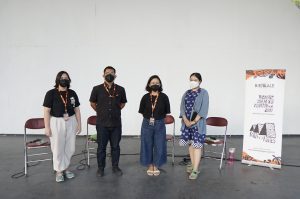We are entering the second week of the Biennale Jogja XVI Equator #6 2021. If a few days ago the Biennale Forum presented participating artists, on Wednesday (13/10/), it was the curator’s turn to take the stage in the Curator’s Speech program.
Curators Elia Nurvista and Ayos Purwoaji, with Putri R.A.E Harbie as assistant curator, were ready to present their material at 04.00 p.m at the Jogja National Museum (JNM) stage. With a black dress code, the afternoon discussion took place in a relaxed manner as an afternoon conversation.
“‘Roots and Routes’ was inspired by the writings of James Clifford. In his book, there’s a discussion about indigenous,” said Putri before explaining further about the background for choosing Roots and Routes as the main headline of this year’s Biennale Jogja.
In the book Returns: Becoming Indigenous in the Twenty-first Century (2013), according to Putri, in the chapter “Indigenous Articulation” there is a discussion about the life of indigenous people in the 21st century. It is said that nowadays, we can no longer distinguish between indigenous people and diaspora communities. And there are many cultures in Oceania where people are nomadic. They move from one place to another and form new roots.
The theme Roots and Routes was chosen because it saw a match with the works displayed at the Biennale Jogja XVI. The scope of the theme covers political issues, land grabbing, modernization, the loss of space for expression, climate crisis, and other problems that occur in Oceanian society.
Ayos tells a little story before deciding on the theme Roots and Routes as the main headline. All three look back at how the division of territory was in the Pacific region after the 50s. The Pacific Ocean, which looks like an empty ocean from the map, raises the question “Whose ocean is this?”. How various forms of decolonization occurred in the communities around Oceania. This condition makes them question the authenticity of indigenous peoples who have been expelled and uprooted from their roots.
“How movement or human mobility continued after colonialism occurred. After maps and means of transportation were found. That’s what makes us question again what is authenticity about? What is root? Meanwhile, there are a lot of people in the diaspora,” Ayos added.
Finally, the book by James Clifford resonated with the theme. Roots <> Routes was then chosen as the big theme to wrap up the works in the main exhibition of the Biennale Jogja XVI.
 Based on this theme, the artists and communities who participated in the Biennale Jogja this time raised issues that talked a lot about the locality, such as the participants from Ambon who raised the topic of reclamation or Papua with freedom of expression. Then there is Lakoat with the loss of local knowledge which is then replaced in the name of development and modernization.
Based on this theme, the artists and communities who participated in the Biennale Jogja this time raised issues that talked a lot about the locality, such as the participants from Ambon who raised the topic of reclamation or Papua with freedom of expression. Then there is Lakoat with the loss of local knowledge which is then replaced in the name of development and modernization.
“These issues do not just arise locally. But it has something to do with other things. If you ask, is the issue still important? Of course. But then, how to make these issues resonate with each other and then have a spirit of solidarity and do something about it. What happened in Ambon, might happen in Vanuatu,” said Elia.
In the end, it’s not just about locality that is the target of this Biennale Jogja. Ayos said there were four keywords formulated from the start by the curator, including decentralization, decolonization, internationalism, and situated knowledge.
“Talking about locality in this Biennale does not necessarily mean locality as exoticism. But one response to the stalled internationalization,” said Ayos.